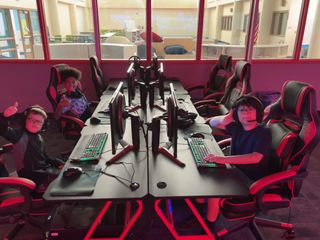Learning doesn’t just take place between the four walls of the traditional classroom, says Glenn Robbins Superintendent and Principal of The Brigantine Public School District in New Jersey. “It also takes place outside and takes place anywhere we go,” Robbins says.
To capitalize on this idea, the preK-8 district recently transformed its indoor and outdoor education spaces. New policies were also instituted to encourage field trips, including short jaunts around Brigantine, or “The Island” as it is often known. These efforts sought to prioritize active and student-led learning as well as take advantage of the natural learning resources available.
Robbins was recently awarded the Innovative Superintendent Award at the Tech & Learning Innovative Leadership Awards in New Jersey. He was honored for his leadership efforts in transforming these student spaces as well as his work integrating technology, encouraging social-emotional learning, and keeping student voice and leadership front and center in everything the district does.
Robbins shares how other educators can rethink their learning spaces and encourage student voice and choice in the process.
Create Inviting Spaces

A guiding principle for Brigantine’s educational space redesigns has been the idea that teachers and students should be excited to be in all school spaces. “You know when you walk into a conference room, and you’re like, ‘Oh man this is gonna be a boring room,’” Robbins says.
Instead of that feeling, Robbins and his team wants to create the opposite. “The second you've walked through that threshold into that building into that room, whatever it may be into that arena, you want the kids to go, ‘Wow, I want to be in here, and it's the same thing for our staff,’” he says.
To that end, the district has incorporated comfortable and more moveable chairs and furniture – revamping the layouts of their library, cafeteria, and individual classrooms to create a more inviting experience that fosters collaboration. The district has also added new gardens, a mindfulness-focused space called the ZEN Den, an interactive video floor, an esports arena with viewing windows, and high-top desk and bike desks in hallways. The district has even renovated the gym floor.

Bring Learning Outside

During COVID the district prioritized outdoor learning by building a robust outdoor teaching area. But teachers were also encouraged to take lessons off campus with mini field trips exploring the oceanside environments near the school. Those efforts have continued.
“We have a blanket field trip form that our board approved for social-emotional learning,” Robbins says. “So our scholars can go on a field trip – as long as the parents know 24 hours ahead of time – down to the beach, to the sea wall, to the golf course, to the Bird Observatory, to anywhere on the island. And that's their outdoor classroom for the day.”
These short walking trips are a low-cost and simultaneously enriching experience for students. These outdoor experiences can simply be a mental health break or a fun trip to the ice cream shop, Robbins says. But these can also be wonderful learning opportunities. “The other day, fifth grade, walked down to the City Hall, and then they also walked over to the library, and all got library cards,” Robbins says.
Incorporate Student Voice

Student input has helped guide the district’s redesign process and continues to influence out-of-classroom experiences and overall learning, Robbins says. This has benefits both for the district and for the students themselves. “They have so many great ideas, and a lot of times students are untapped resources,” Robbins says. “We think we know it all because of what we experienced in the past, and we got to do that again for them, but this is a brand-new world.”
Not only can educators learn from their students but bringing them into discussions around school design can foster the student-centered learning many districts seek to encourage. “If we're not giving them an opportunity to even partake in these types of meetings, then how are we ever actually going to get them to do it in the real world? How are we going to get it infused into the lessons?” Robbins says. “When I have those meetings with the kids, they get a lot more empowered, and they start doing more and more things. Then they are not bashful about coming up to you and having those conversations instead of running away from the superintendent, they actually want to talk and say, ‘Hey, we did this, could we maybe try this too?’”
One recent student-led initiative in Brigantine is an effort to bring in a different local restaurant each week to provide lunch on Fridays.
Work With Other Education Leaders But Recognize Your District is Unique

Robbins advises school leaders looking to redesign their spaces to connect with other educators and share best practices. For example, one cost-saving strategy can be to buy furniture collectively, which can lead to more significant discounts for your district.
However, education leaders should not try and compete with other districts or think what worked someplace else will automatically work for their district. “Many places get thrown money, and they just buy the new coolest thing because 'the school down the street has two of them, and we want three,'” Robbins says. “I think you have to look at it from the lens of what is your school? What makes you unique? And what does your school need? Because there is no silver bullet, there is no best practice at another school that is going to be an exact replica in my school because it's a completely different clientele, completely different community.”
So before embarking on any major renovation, it’s a good idea to take a long look in the mirror and see what makes sense for your district or school. “You have to focus within instead of focusing on trying to compete with others,” Robbins says.

